It looks like you're using an Ad Blocker.
Please white-list or disable AboveTopSecret.com in your ad-blocking tool.
Thank you.
Some features of ATS will be disabled while you continue to use an ad-blocker.
share:
I've been working as a graphic artist type dude for awhile now and I just finished Richard
Hoagland's book Dark Mission & after following one of the resource links supplied in the book, I set out
to reproduce his work with the images available on the net. In the book, Hoagland demonstrates the difference in the effect one can get from the
photo AS14-66-9301 also known as "Mitchell Under Glass". I was able to recreate
what was demonstrated in the book with these net-accessible images. In it you can clearly see that there is "something" in the background.
Here's a look at a low resolution version of the original downloadable version:
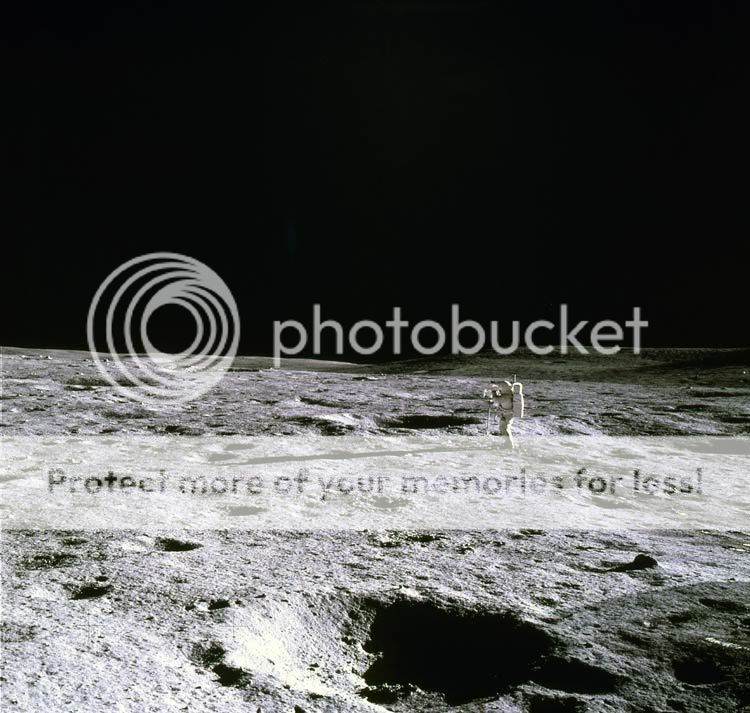
___________
Even without any processing you can kind of see something that looks like a "smudge" in the center.
Here's what you get when you increase the Brightness by a factor of 50% & the contrast increased by 25%:
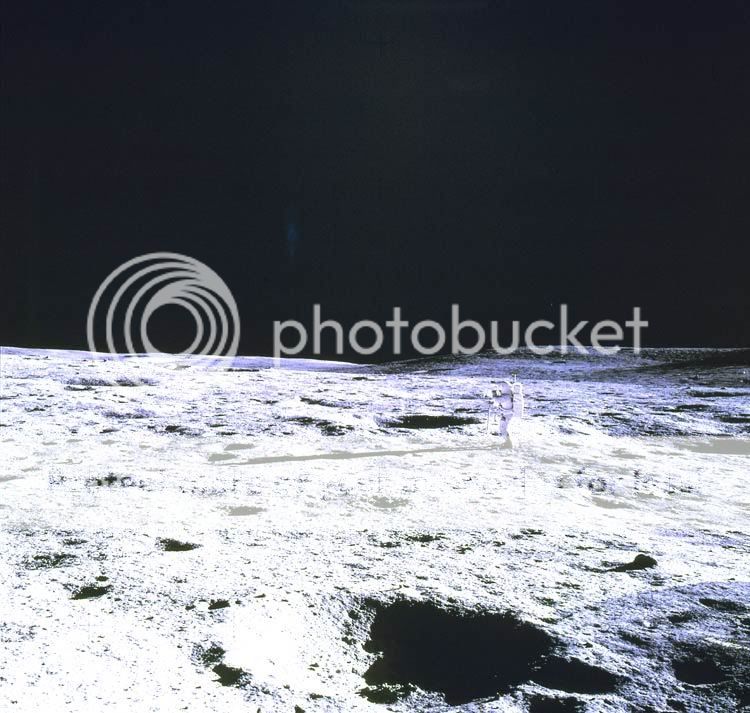
___________
In this version you can clearly see what Hoagland illustrates as a meteorite hole in the center and off to the upper right. You can also see what seems to be light diffusion in the center of the image. If there was no atmosphere or anything there, it would be black and not diffuse like that. The angle & intensity of light wouldn't account for some kind of lens flare either from what I can tell.
Here's another "enhanced" detail using the color channels & curves:
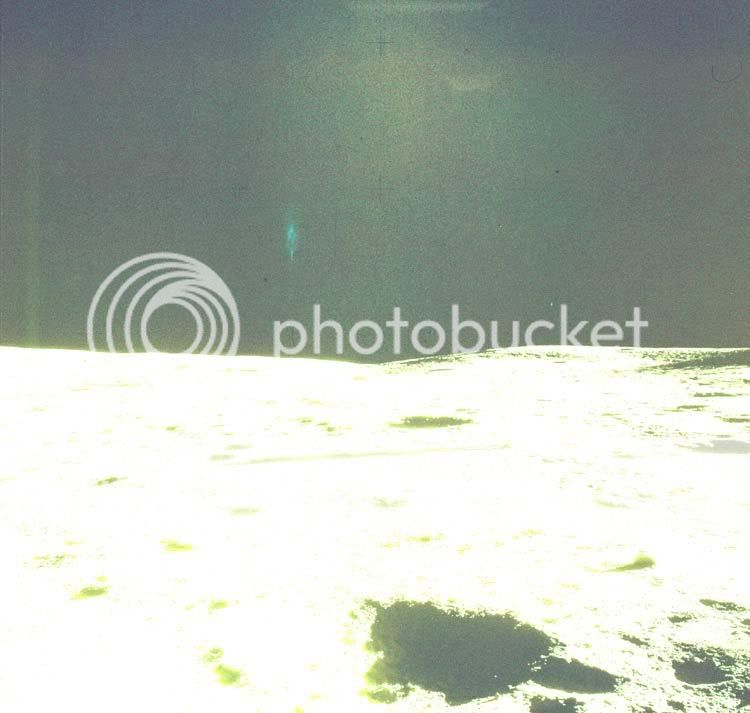
______________
This one you can really see those "anomalies" in the background as well as the centralized light diffusion in the background. As if reflecting off of & through "something".
And here is photo AS17-134-20426 from Apollo 17 Mission with Scientist-Astronaut Harrison H. Schmitt collecting samples of the surface that Hoagland said he'd "bet the farm" on during his great Project Camelot Interview. After downloading this image for myself I can understand why. I cannot explain why that prism would show up in the sky like that. For one the moon isn't supposed to have an atmosphere let alone a orange-ish-pink haze let alone one perfectly linear prism and other odd shaped ones littered through out. if it was a lens defect, it would be seen in other photos too. It appears to me that those prisms are in the background and no present on the lens of the camera.
Here is a low resolution version of the original downloadable photo:
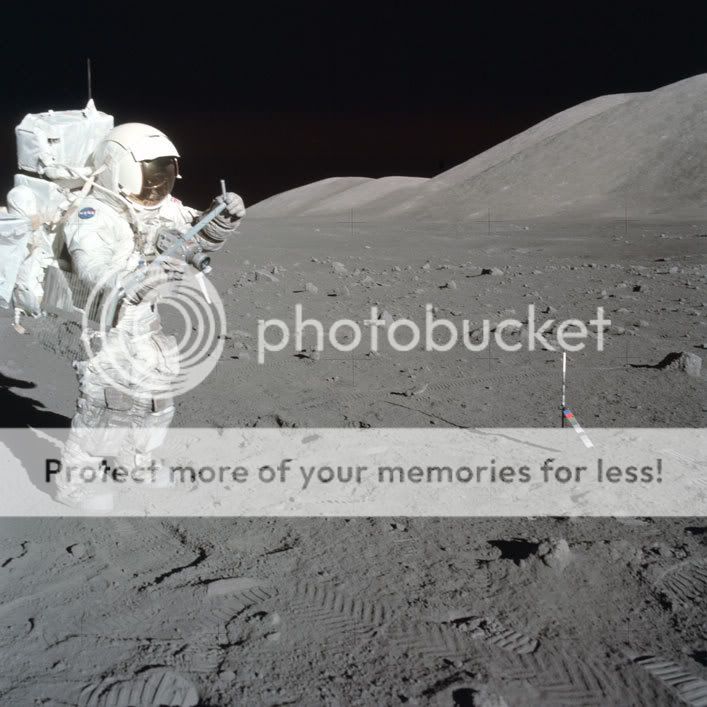
________________
It's a bit hard to see at first glance, but you can see the prism in the background.
Here's a close up of the area in question with the linear prism:
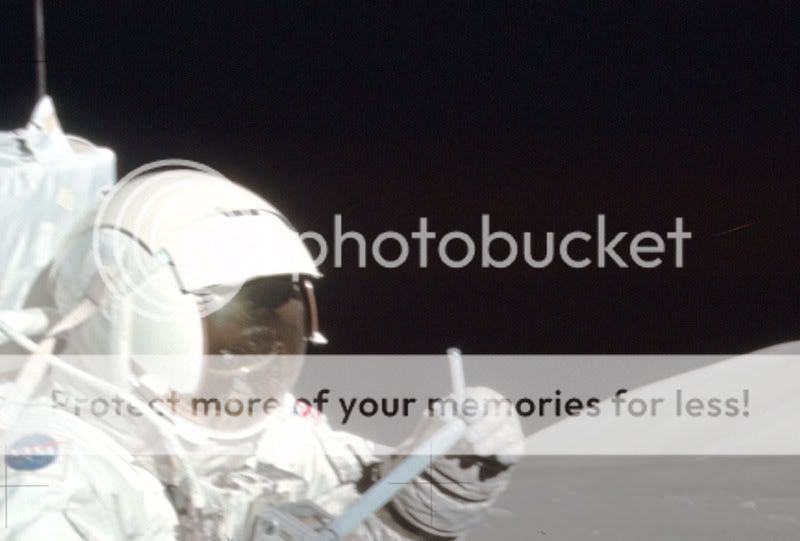
________________
Aaaah that's better, a little closer? You got it!
An even closer detail with the Brightness & contrast turned up:

________________
In that one you can see the other mini prisms in the background as well as some kind of dark spot on the right side by the mountain slope. Still want to get closer? hell yeah, here you go!
Even closer with a reference:

________________
So unless someone is firing a rainbow colored laser beam through the reportedly non-existent or incredibly thin lunar atmosphere, or there might just be something else there....hm, who knows? :thumb_yello:
Here's a close up of the right side anomalous dark spot and the "dot":

________________
Hoagland didn't talk about that, so I don't know if that's been put in later due to generation transfer, of if it's evidence of prior editing, either way, I noticed that within the same layer of information as some of the other detail. Also when referencing the book, it appears that discolored area is in that picture to (color fig 8 in the book).
While browsing www.spacearchive.net I noticed photo AS12-46-6826 that for some reason the astronaut pictured seem to have a blue haze around him or something. From the thumbnail I thought maybe it was a lens flare but figured I'd check it out.
Here's a low res version of the downloadable original:
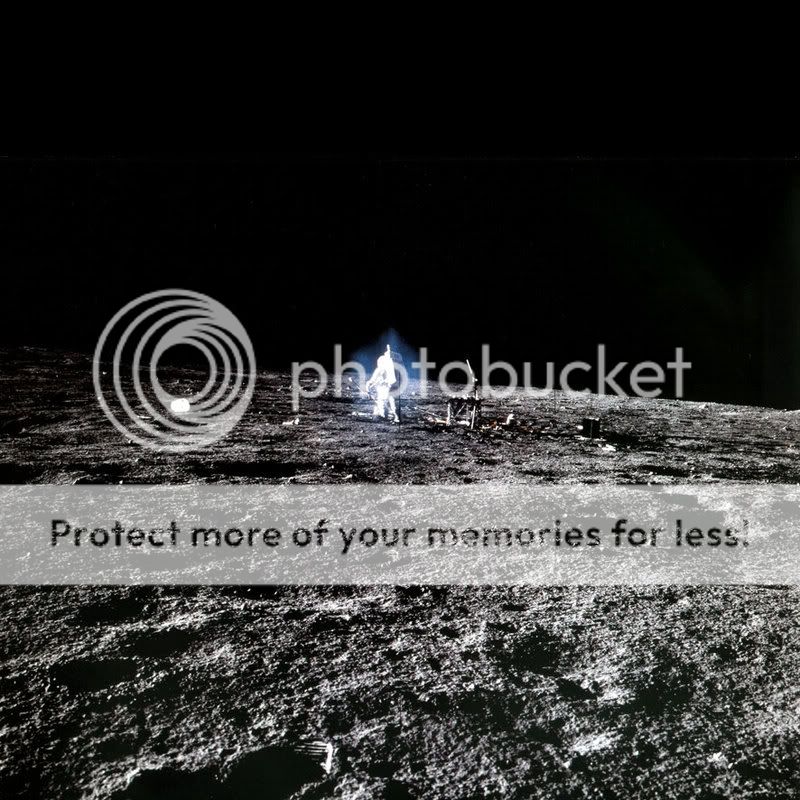
________________
Kind of odd, not sure what that was about. So I figured I'd just increase the brightness & contrast like the other images & here's what I got:
Original Image with increased brightness & contrast:
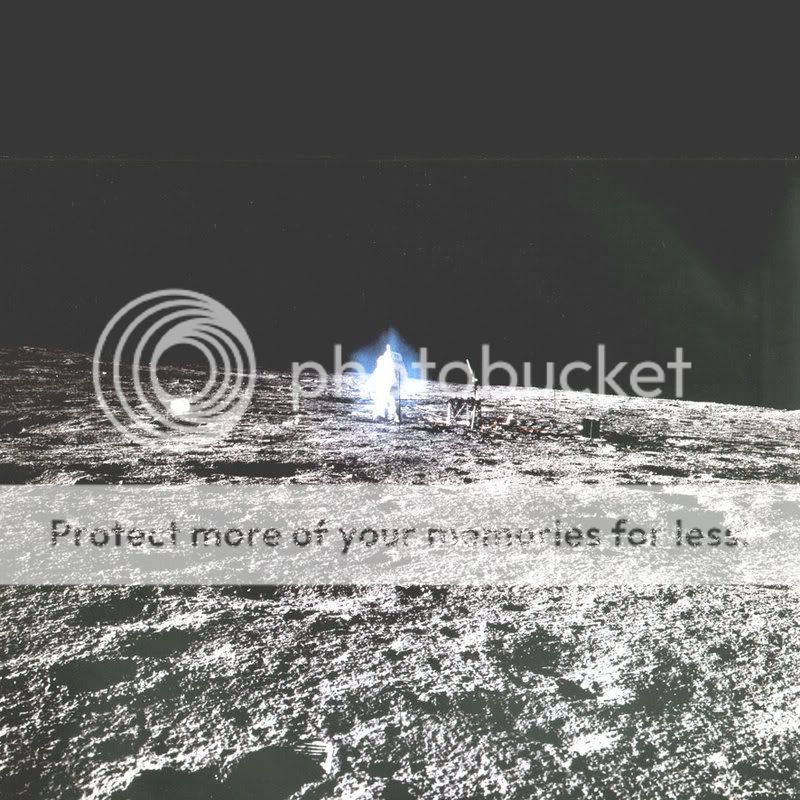
________________
Holy $H_7 Balls Batman!! Wtf is that?! Not sure, but unless someone decided to take a picture with a glass slide in front of the camera, I would almost say there is some kind of structure or "thing" on the landscape...what do you think? These anomalous artifacts do not seem to appear in subsequent photos from what I've seen so far.
So I decided to see if I could play with the color channels and a few other filters to see if I could bring out more detail from the background. Here's what I got.
Fun with curve, color, contrast, and sharpness:
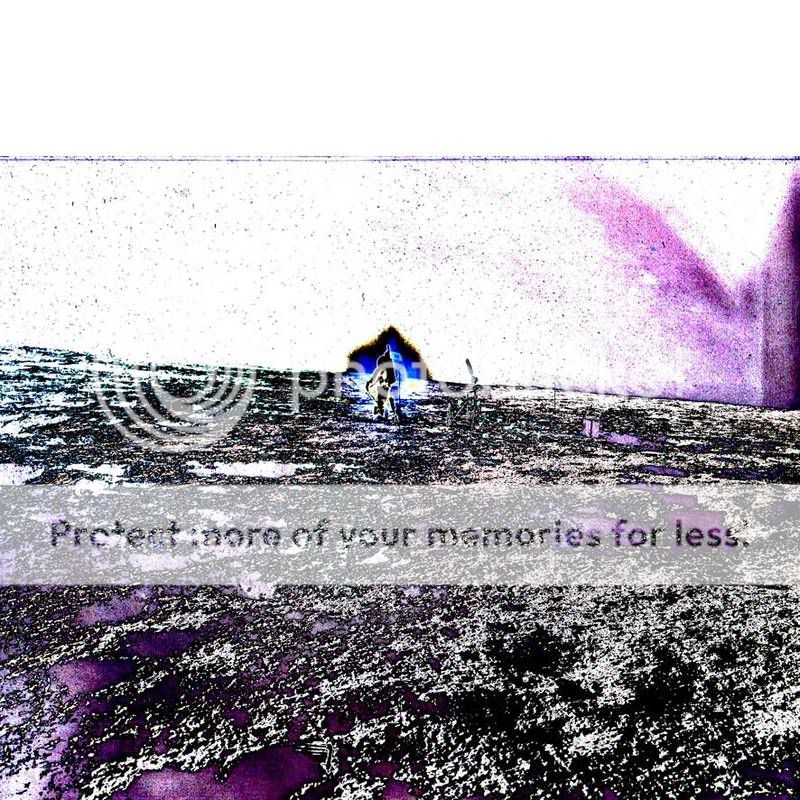
I'm still working on seeing what I can do with this photo as well as working on the "Robot head" photo. I want to see if I can preserve the color information and duplicate the "red lip" Hoagland has illustrated in his book(Color Fig 28 in the book). Either way, there really does seem to be some study-worthy "features" on the moon & mars and Hoagland definitely present quiet a bit of evidence that there is in fact a conspiracy to withhold information and images from space. I'm glad we get to see what we do after hearing what has happened in the past honestly...
Here's a look at a low resolution version of the original downloadable version:

___________
Even without any processing you can kind of see something that looks like a "smudge" in the center.
Here's what you get when you increase the Brightness by a factor of 50% & the contrast increased by 25%:

___________
In this version you can clearly see what Hoagland illustrates as a meteorite hole in the center and off to the upper right. You can also see what seems to be light diffusion in the center of the image. If there was no atmosphere or anything there, it would be black and not diffuse like that. The angle & intensity of light wouldn't account for some kind of lens flare either from what I can tell.
Here's another "enhanced" detail using the color channels & curves:

______________
This one you can really see those "anomalies" in the background as well as the centralized light diffusion in the background. As if reflecting off of & through "something".
And here is photo AS17-134-20426 from Apollo 17 Mission with Scientist-Astronaut Harrison H. Schmitt collecting samples of the surface that Hoagland said he'd "bet the farm" on during his great Project Camelot Interview. After downloading this image for myself I can understand why. I cannot explain why that prism would show up in the sky like that. For one the moon isn't supposed to have an atmosphere let alone a orange-ish-pink haze let alone one perfectly linear prism and other odd shaped ones littered through out. if it was a lens defect, it would be seen in other photos too. It appears to me that those prisms are in the background and no present on the lens of the camera.
Here is a low resolution version of the original downloadable photo:

________________
It's a bit hard to see at first glance, but you can see the prism in the background.
Here's a close up of the area in question with the linear prism:

________________
Aaaah that's better, a little closer? You got it!
An even closer detail with the Brightness & contrast turned up:

________________
In that one you can see the other mini prisms in the background as well as some kind of dark spot on the right side by the mountain slope. Still want to get closer? hell yeah, here you go!
Even closer with a reference:

________________
So unless someone is firing a rainbow colored laser beam through the reportedly non-existent or incredibly thin lunar atmosphere, or there might just be something else there....hm, who knows? :thumb_yello:
Here's a close up of the right side anomalous dark spot and the "dot":

________________
Hoagland didn't talk about that, so I don't know if that's been put in later due to generation transfer, of if it's evidence of prior editing, either way, I noticed that within the same layer of information as some of the other detail. Also when referencing the book, it appears that discolored area is in that picture to (color fig 8 in the book).
While browsing www.spacearchive.net I noticed photo AS12-46-6826 that for some reason the astronaut pictured seem to have a blue haze around him or something. From the thumbnail I thought maybe it was a lens flare but figured I'd check it out.
Here's a low res version of the downloadable original:

________________
Kind of odd, not sure what that was about. So I figured I'd just increase the brightness & contrast like the other images & here's what I got:
Original Image with increased brightness & contrast:

________________
Holy $H_7 Balls Batman!! Wtf is that?! Not sure, but unless someone decided to take a picture with a glass slide in front of the camera, I would almost say there is some kind of structure or "thing" on the landscape...what do you think? These anomalous artifacts do not seem to appear in subsequent photos from what I've seen so far.
So I decided to see if I could play with the color channels and a few other filters to see if I could bring out more detail from the background. Here's what I got.
Fun with curve, color, contrast, and sharpness:

I'm still working on seeing what I can do with this photo as well as working on the "Robot head" photo. I want to see if I can preserve the color information and duplicate the "red lip" Hoagland has illustrated in his book(Color Fig 28 in the book). Either way, there really does seem to be some study-worthy "features" on the moon & mars and Hoagland definitely present quiet a bit of evidence that there is in fact a conspiracy to withhold information and images from space. I'm glad we get to see what we do after hearing what has happened in the past honestly...
Here's the notorious AS17-137-20997 AKA Shorty crater, aka Data's head, aka
C3PO's head. This image was really hard to work with. I would love to come in contact with a higher resolution version that I am working
with(2340x2364 @ 300ppi can't remember where I dl'ed it from though). I still was able to get a good amount of detail out of the image I think.
Here's a low resolution version of the original downloadable version:
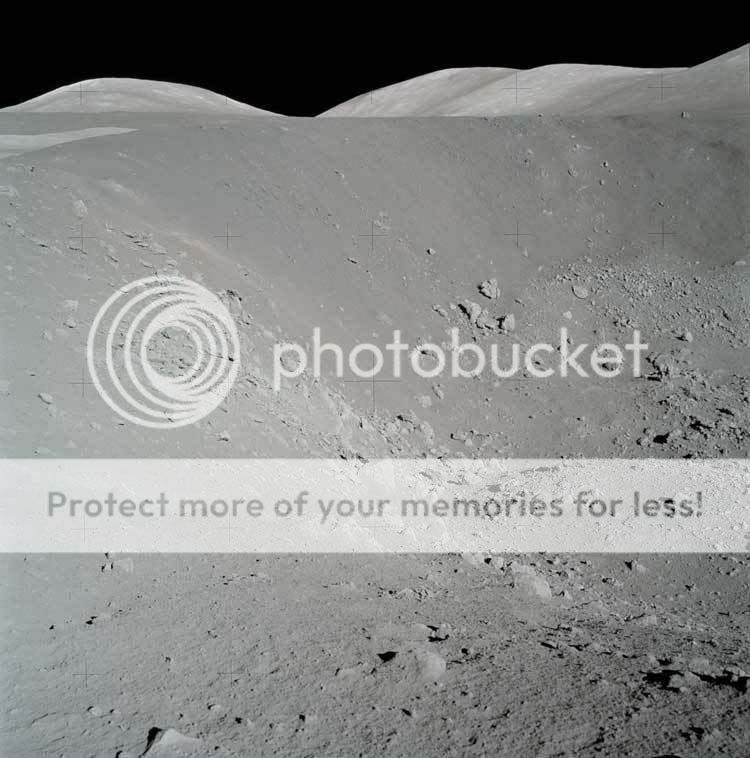
________________
If you're wondering where the head is, it's just to the bottom right of the reticle.
Here's a closer crop of the head area:
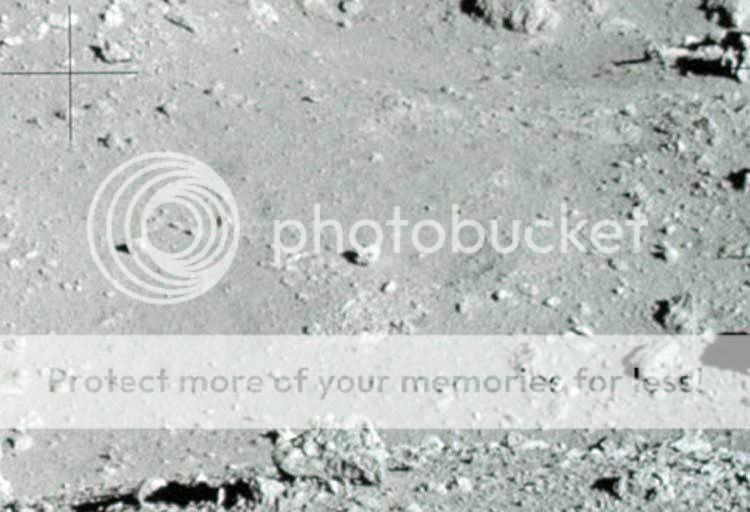
________________
You can see the object in question right in the center now.
Here's a detail shot of the face with slight level adjustment:

_______________
The pixel compression is really factor when dealing with this image. After this version I started using a slight gaussian blur to help filter out the interference pattern and maybe help distinguish detail of the object versus the background/noise.
Here's a detail shot of the face with the curves & brightness adjusted:
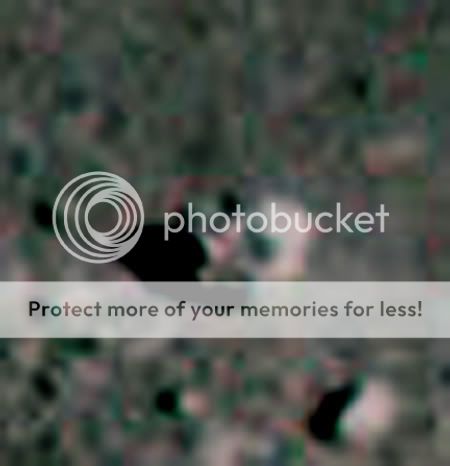
________________
In this shot you can see a bit of the red lip that Hoagland illustrates in the book with with Color Fig. 28 in the book.
For the hell of it, I embossed the last image too to see what I got:
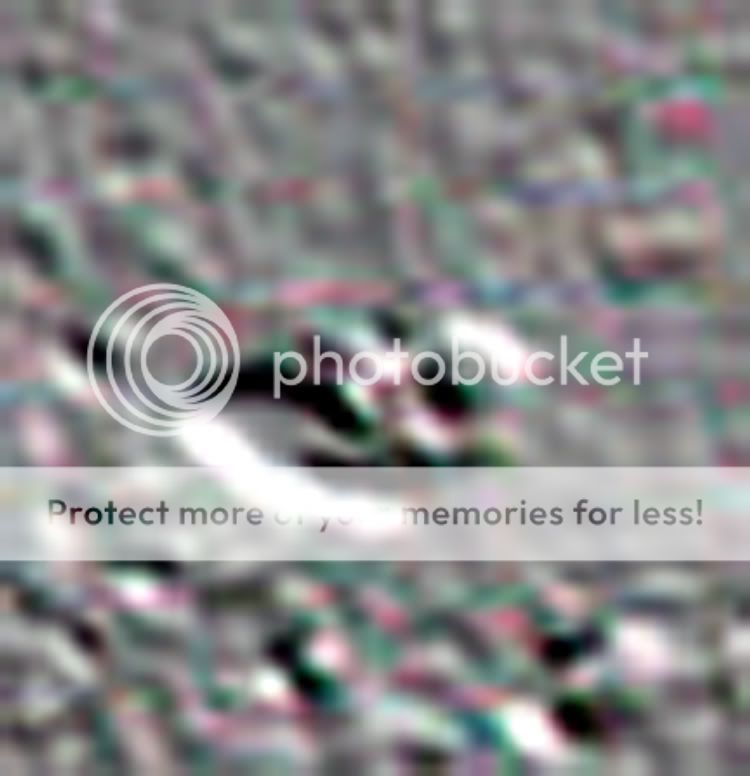
________________
Kind of interesting...
Here's a better look at the red lip using the color channels to enhance the detail:

_______________
It was hard to pull up that much information on the red lip as Hoagland put it. Maybe with a higher resolution image as the object is fairly small in the field of view it would allow for sharper magnification and more color info in general.
Either way that's the head!
AS12-46-6826 is still pretty mind boggling to me. It looks like there is some kind of angle change on that image too. It sort of looks like there is a 30 degree slant away from the camera with the "structure" being a flat topped building.
Here's a low resolution version of the original downloadable version:

________________
If you're wondering where the head is, it's just to the bottom right of the reticle.
Here's a closer crop of the head area:

________________
You can see the object in question right in the center now.
Here's a detail shot of the face with slight level adjustment:

_______________
The pixel compression is really factor when dealing with this image. After this version I started using a slight gaussian blur to help filter out the interference pattern and maybe help distinguish detail of the object versus the background/noise.
Here's a detail shot of the face with the curves & brightness adjusted:

________________
In this shot you can see a bit of the red lip that Hoagland illustrates in the book with with Color Fig. 28 in the book.
For the hell of it, I embossed the last image too to see what I got:

________________
Kind of interesting...
Here's a better look at the red lip using the color channels to enhance the detail:

_______________
It was hard to pull up that much information on the red lip as Hoagland put it. Maybe with a higher resolution image as the object is fairly small in the field of view it would allow for sharper magnification and more color info in general.
Either way that's the head!
AS12-46-6826 is still pretty mind boggling to me. It looks like there is some kind of angle change on that image too. It sort of looks like there is a 30 degree slant away from the camera with the "structure" being a flat topped building.
My only comment would be to the first image.
In fact the light angle in that photo could create a lens flare or glare. It seems to come from around 2 o'clock and that's enough direct light to mess things up a little.
About the diffuseness. We have to remember that even though it might have been state of the art gear back then, the cameras were somehow volatile and the film could have been exposed or processed badly or at least insufficiently.
The coatings back then could completely deal with chromatic aberations etc.
The small rifts and prisms in one of the later images coudl be down to bad grain in the film. Film are comprised of very small pieces of grain that are sensitive to either red, green or blue. Even with todays gear or gear from a few years ago you could sometimes get situations where a piece of grain would "spill" onto its neighbours. Especially with high light sensitive film because it uses large grains.
That's also why you start to notice how the black background seems to have dots of red green and blue.
If there's one thing high grain film can't take it's being lightend too much in the dark areas :S
The ghostly effect around the astronaut is curious though. I don't have a clue why it is there. It seems intentional. I mean, why only around him when there is so much space in the photo otherwise.
Could be extremely bad dodging in the dark room or something. But that's a guess not a conclusion...
The top of that image looks like it's been added afterwards. It's just too clean and smooth. Maybe for aesthetics, a better crop? Dunno...
[edit on 12/10/08 by flice]
In fact the light angle in that photo could create a lens flare or glare. It seems to come from around 2 o'clock and that's enough direct light to mess things up a little.
About the diffuseness. We have to remember that even though it might have been state of the art gear back then, the cameras were somehow volatile and the film could have been exposed or processed badly or at least insufficiently.
The coatings back then could completely deal with chromatic aberations etc.
The small rifts and prisms in one of the later images coudl be down to bad grain in the film. Film are comprised of very small pieces of grain that are sensitive to either red, green or blue. Even with todays gear or gear from a few years ago you could sometimes get situations where a piece of grain would "spill" onto its neighbours. Especially with high light sensitive film because it uses large grains.
That's also why you start to notice how the black background seems to have dots of red green and blue.
If there's one thing high grain film can't take it's being lightend too much in the dark areas :S
The ghostly effect around the astronaut is curious though. I don't have a clue why it is there. It seems intentional. I mean, why only around him when there is so much space in the photo otherwise.
Could be extremely bad dodging in the dark room or something. But that's a guess not a conclusion...
The top of that image looks like it's been added afterwards. It's just too clean and smooth. Maybe for aesthetics, a better crop? Dunno...
[edit on 12/10/08 by flice]
If you see Hoagland's higher resolution version of the Mitchell Under Glass shot you can see that it's no lens flare. If it was anything
conventional it would be scratches on the lens or film would be the likeliest of excuses, but we'd see more of the same kind of anomalies on other
shots in the same position too if that was the case. Especially with the item of the prism.
I would love for someone to produce a a "lens flare" that turns out to be a prism like that without; an obvious scratch on the lens or comparable lighting intensity. Not to mention there are more then one prismatic artifacts in the shot. Mess up on the film? Once again, wouldn't there be other examples of this too on that roll then too? We'd also be throwing out all of the other "prism-like" anomalies that are visible in the images such as the pink/orange haze in the shot.
That pink & orange haze is on other shots on the moon too. Hoagland goes into detail about what kind geological conditions (or artificial) can cause that. Either way it's light refracting, but refracting off of what is the interesting question. Hoagland has some great shots of the hills from NASA photo AS17-147-22465 where if you correct the color by calibrating to the probe you get a pink/orange/purple sheen off of the hills. His theory is essentially that the lunar surface is littered with this shattered super-glass that due to low angle refraction of all of this silica causes that pink, orange, and purple lighting effect.
I'll try to reproduce that one here too if I can. I'm going through and finding the image I can and keeping my eye out for any other "interesting" things I noticed a long the way.
For those who want to try this but don't have Photoshop, here's a link to a freeware Photoshop copy that rocks fairly hard so you can try on your own.
GIMP
I would love for someone to produce a a "lens flare" that turns out to be a prism like that without; an obvious scratch on the lens or comparable lighting intensity. Not to mention there are more then one prismatic artifacts in the shot. Mess up on the film? Once again, wouldn't there be other examples of this too on that roll then too? We'd also be throwing out all of the other "prism-like" anomalies that are visible in the images such as the pink/orange haze in the shot.
That pink & orange haze is on other shots on the moon too. Hoagland goes into detail about what kind geological conditions (or artificial) can cause that. Either way it's light refracting, but refracting off of what is the interesting question. Hoagland has some great shots of the hills from NASA photo AS17-147-22465 where if you correct the color by calibrating to the probe you get a pink/orange/purple sheen off of the hills. His theory is essentially that the lunar surface is littered with this shattered super-glass that due to low angle refraction of all of this silica causes that pink, orange, and purple lighting effect.
I'll try to reproduce that one here too if I can. I'm going through and finding the image I can and keeping my eye out for any other "interesting" things I noticed a long the way.
For those who want to try this but don't have Photoshop, here's a link to a freeware Photoshop copy that rocks fairly hard so you can try on your own.
GIMP
I'm about half way through his book myself, and find his investigative trails incredibly riveting, with enormous implications. Great thread.
Starred and flagged.
Hey thanks I would love to get my hands on some of the versions Hoagland has or atleast a copy of some kind of some of the apollo images and mars
ones. I'm trying to track down more shots of the moon and mars that he used in the book to see if I can do anything with them. I'll post whatever
else I managed to find.
reply to post by Shakesbeer
Being a graphic artist type dude, I'm sure you are aware that the process of scanning film to a digital format often introduces artifacts.
I am also sure you are aware that resizing and "filtering" does not reveal information that was not in the original but, in fact, often creates new, false information.
Please keep this in mind as you peruse the contents of this site:
www.apolloarchive.com...
(don't tell anyone else...it's a secret)
[edit on 13-10-2008 by Phage]
Being a graphic artist type dude, I'm sure you are aware that the process of scanning film to a digital format often introduces artifacts.
I am also sure you are aware that resizing and "filtering" does not reveal information that was not in the original but, in fact, often creates new, false information.
Please keep this in mind as you peruse the contents of this site:
www.apolloarchive.com...
(don't tell anyone else...it's a secret)
[edit on 13-10-2008 by Phage]
this is really great work and i look forward to more photos ... i was wondering could the pictures have been taken from outside a glass window of a
vacuum chamber big enough for a moon set to have been built ...
Phage - Yeah thanks. That's why I'm very mindful as to how much alteration I do and I'm trying to give as much detail about what & how I'm doing
this so others can see how to preserve as much of the original information as possible. I know first hand that if given enough time one can create
anything visually especially on a computer screen. I'm trying to duplicate stuff that doesn't take a stretch of imagination to look and see "hey I
don't know what that thing is but it doesn't look like just a rock..." With that being said, I can't image what would cause the artifacts on
AS12-46-6826 without literally putting something glass strategically in front of the lens or scan, or there's a big "object" in that shot.
Oh and thanks for the link, I'll see if I can find any other images I've been unable to get good versions of there too.
Fatdad - thanks. It sounds like there where quiet a few lunar reproductions for various reasons at various times(including the astronaut themselves redoing it for book promo shots). I can't imagine why if the entire landing is a fake would they include these anomalies in the shots if their entire record is of them denying the existence of this kind of stuff?
[edit on 13-10-2008 by Shakesbeer]
Oh and thanks for the link, I'll see if I can find any other images I've been unable to get good versions of there too.
Fatdad - thanks. It sounds like there where quiet a few lunar reproductions for various reasons at various times(including the astronaut themselves redoing it for book promo shots). I can't imagine why if the entire landing is a fake would they include these anomalies in the shots if their entire record is of them denying the existence of this kind of stuff?
[edit on 13-10-2008 by Shakesbeer]
reply to post by Shakesbeer
Source
Pete took this partial pan from the southeast rim of Middle Crescent just before he and Al headed back for the LM. The frames are AS12-46- 6836 to 6844. Note the strong colors at the center of the righthand frames. Examination of successive frames indicate that this related to the camera lens, very likely a dust smudge. Kipp Teague notes "The lens aberration begins at as12-46-6813. It's a blue glow around the astronaut in 6818, again in 6826, a discoloration in other frames, affecting clarity in most, and it's not gone again until 6853 (back in the LM). Whatever the phenomenon is, it has a varying impact on color based on the brightness of the central object in the image. On bright subjects, the aberration adds a blue cast, and on darker subjects, the aberration adds a reddish cast." I note that it also seems to vary with sun angle.
Source
I was going to guess swamp gas but who knows -shrugs-(sorry, just had to add that seeing as it is a .gov reference)...but if that's right then
there's a strategic banding of some kind across the lens. If you look at the light refraction around the right side of the frame would also have an
over exposure on the ground as well and it does not extend into the foreground. I would like to get a hold of subsequent and prior shots of that
frame and see if there's anything in the background still.
reply to post by Shakesbeer
They are all available at the link I gave previously and yes, it appears to be consistent with a smudge on the lens.
They are all available at the link I gave previously and yes, it appears to be consistent with a smudge on the lens.
I don't know, I have yet to recreate anything that looks like what's in shot 46-6826 in the shots around it. There does appear to be a consistent
discolorization in the center which could account for the astronaut being hazed out, but it doesn't account for the straight line bisecting the sky
as well as what appears to be a plane-like shift towards the right side. If the light was catching this oddly shaped lens, or maybe a protective
housing I can see that. But I haven't seen the the any other picture bisected so blatantly let alone see any other noise in the background that
wouldn't be consistent with a normal unimpeded horizon shot or with what is present in 6826. The other ASLEP deployment images aren't at a wide
enough angle to see if the same thing shows up at the same angle. Here's a comparison of 6826 & 6806 with 06 having a very exposed front end of the
camera with a strong lens flare. We should be able to technically see part of the curvature of the lens as well as compare it to the shape of the of
28. Here you go.

Also on the website you supplied there Phage it doesn't have the images leading up to 6826, only up to 24 & doesn't pick up again until 41.
Even if there is a smudge or some kind or dust on the center of the lens, the "curvature" of the lens from the over exposed shot compared to the 26 still isn't consistent on the shot above or the ones available on apolloarchive. Likewise we apparently have no way of comparing the shots around it so....anyone got 6825, 6827-40?!

Also on the website you supplied there Phage it doesn't have the images leading up to 6826, only up to 24 & doesn't pick up again until 41.
Even if there is a smudge or some kind or dust on the center of the lens, the "curvature" of the lens from the over exposed shot compared to the 26 still isn't consistent on the shot above or the ones available on apolloarchive. Likewise we apparently have no way of comparing the shots around it so....anyone got 6825, 6827-40?!
reply to post by Shakesbeer
As I said, all of the images are there. Here is the first one described as having the flaw www.hq.nasa.gov...
Please feel free to change the image ID in the URL all the way up to 6852, the last one described as having the flaw.
The photographs on the surface of the moon were taken using a Biogon f-5.6/60 mm lens, A very high quality lens designed for the Apollo missions. The lens/camera combination was carefully calibrated to minimize distortion in order to allow accurate analysis. It was not an "oddly shaped" lens.
I would hold your source images suspect. No source of the photographs is given on the website but it is highly unlikely that the scans were made from the original film. It is very likely that the images on spacearchive.com are from copies of copies and as the owner of the site says:
The image you are using has been worked over before you got you hands on it. It is evident that the artifacts which you have found are the result of this.
[edit on 13-10-2008 by Phage]
As I said, all of the images are there. Here is the first one described as having the flaw www.hq.nasa.gov...
Please feel free to change the image ID in the URL all the way up to 6852, the last one described as having the flaw.
The photographs on the surface of the moon were taken using a Biogon f-5.6/60 mm lens, A very high quality lens designed for the Apollo missions. The lens/camera combination was carefully calibrated to minimize distortion in order to allow accurate analysis. It was not an "oddly shaped" lens.
I would hold your source images suspect. No source of the photographs is given on the website but it is highly unlikely that the scans were made from the original film. It is very likely that the images on spacearchive.com are from copies of copies and as the owner of the site says:
Source
Many pictures were restored by me, restoring the original colors, enhancing the contrast, removing scrubs, scratches and dust maks. I hope that this work helps to remember in the best way the epic of space exploration and the men who were involved.
The image you are using has been worked over before you got you hands on it. It is evident that the artifacts which you have found are the result of this.
[edit on 13-10-2008 by Phage]
Woah dude kind of sounds like you're dictating at me here. All I said is that I specifically was reproducing the images that Hoagland talked about
in his book. I found the other one that had something odd and all I'm saying is that it seems hard to explain what is in the background of 6826. As
far as the source being "suspect" look up what Michael Malin apparently likes to release as
"official" images...
Release by JPL April 6 1998
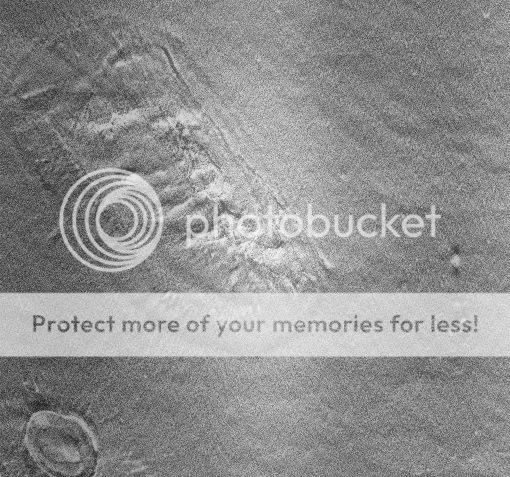
-cough-emboss filter-cough-.....
Then shortly after we got this one(the next day if I'm not mistaking) after many people complained to John McCain of all people:
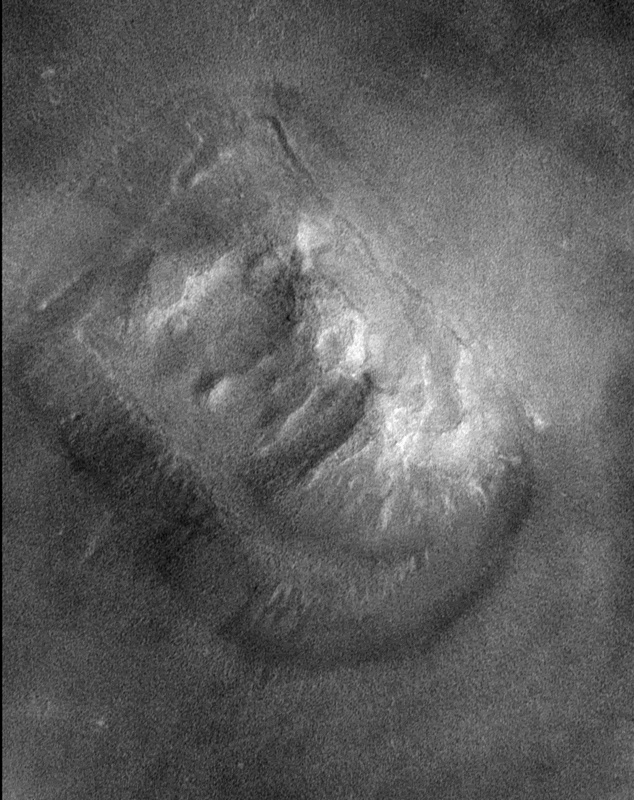
And the famous 3D image of the face. Funny how they seem to spend a lot of time there for some place that "isn't interesting" huh?
Hoagland goes into a lot of detail about the commercialization of NASA and all the rights to the images from the space craft for a year and completely up to their disclosure as to what they actually do share. We're lucky to even get the "Cat Box" version of Cydonia technically. So yeah I'm sure the images I'm working on have been degradated maybe even manipulated, the questions I have is then by who, when, & why? That's before whoever the site owners got to them that is. Where is your evidence that the images on apolloarchive are "all" of the images despite what the cataloging seems to indicate?
Not to mention I didn't say the camera was odd shaped or even in a housing for that matter, I said "if" & "maybe", as in hypothetically. I read all about the optics in the book too. I was just humoring the theory really. All I'm saying is that that "object" can't be reproduced from the information we apparently have available and your theory does not seem sufficient to explain away what's being seen in the background entirely without some kind duplication of that same kind of light refraction on the right side. Unless you got the images to back it up, then by all means. I'm not assuming I'm right, just posing questions & posting pics..
Release by JPL April 6 1998

-cough-emboss filter-cough-.....
Then shortly after we got this one(the next day if I'm not mistaking) after many people complained to John McCain of all people:

And the famous 3D image of the face. Funny how they seem to spend a lot of time there for some place that "isn't interesting" huh?
Hoagland goes into a lot of detail about the commercialization of NASA and all the rights to the images from the space craft for a year and completely up to their disclosure as to what they actually do share. We're lucky to even get the "Cat Box" version of Cydonia technically. So yeah I'm sure the images I'm working on have been degradated maybe even manipulated, the questions I have is then by who, when, & why? That's before whoever the site owners got to them that is. Where is your evidence that the images on apolloarchive are "all" of the images despite what the cataloging seems to indicate?
Not to mention I didn't say the camera was odd shaped or even in a housing for that matter, I said "if" & "maybe", as in hypothetically. I read all about the optics in the book too. I was just humoring the theory really. All I'm saying is that that "object" can't be reproduced from the information we apparently have available and your theory does not seem sufficient to explain away what's being seen in the background entirely without some kind duplication of that same kind of light refraction on the right side. Unless you got the images to back it up, then by all means. I'm not assuming I'm right, just posing questions & posting pics..
Sorry, I misread what you said earlier about an odd shaped lens.
My point was that the image you used has obvious flaws. Did you download the high rez version of it? It is full of dust and scratches. What you see as a background is the result of scanning an old print.
I do believe the archive does contain all the images since each roll is documented but what I was specifically referring to in my statement was all the images that contain the blur in the center of the frame.
I gave you the links to the images and I'd like to discuss it more but since you've now gotten to the "dog ate my homework" stage I'll bid adieu. Since you don't believe a true record is available, there is no common ground on which to continue.
Oh, one more thing, Hoagland books are not worth the paper they are printed on.
[edit on 14-10-2008 by Phage]
My point was that the image you used has obvious flaws. Did you download the high rez version of it? It is full of dust and scratches. What you see as a background is the result of scanning an old print.
I do believe the archive does contain all the images since each roll is documented but what I was specifically referring to in my statement was all the images that contain the blur in the center of the frame.
I gave you the links to the images and I'd like to discuss it more but since you've now gotten to the "dog ate my homework" stage I'll bid adieu. Since you don't believe a true record is available, there is no common ground on which to continue.
Oh, one more thing, Hoagland books are not worth the paper they are printed on.
[edit on 14-10-2008 by Phage]
So with the pictures starting with AS15-88-11932 (view from LM following EVA-3), these blue streaks are just scratches or imperfections? I was
thinking with some of the pictures the black sky looked a little too black.
[edit on 14-10-2008 by mystiq]
[edit on 14-10-2008 by mystiq]
That series was taken from inside the LM, through the window. I would venture a guess that might have something to do with it.
There are other images with similar thingies but not to the extent of these ones.
There are other images with similar thingies but not to the extent of these ones.
Phage, I don't know dude, look at the cat box image and tell me you can trust everything we're shown. When I say "we're lucky" to get what we do
I mean it. Thank you Mr. Malin, I know now you don't have to even put up with any of this if you really really didn't want to(where ever you
are). 2nd, have you read Hoagland's books or are you just speculating yourself without reviewing his evidence? The guy was selected by former
President Bush to speak at NASA on their close circut tv and everything. If the guy was so FOS why would they do that? To discredit him? Especially
after all the other debates and appearances. Now I'm susposed to be believe you over the guy who sat there in NASA doing research? Sorry,
you're just going to have bring more evidence to the table if you're trying to disprove him.
So how do you know those are all the images, you never answered?
Another possibility on that 6826 image is that maybe the original image was expanded later to have a black background beyond the original one by the site owner...or there's something in the background.
Not to mention there really isn't a good explanation for the prism (No emulsions alone can't explain those away sorry) especially with the "haze" seen on quiet a few different lunar shots that do not appear to be smudges. Lens flare would be the best excuse for that one too, but how many times can that be used before it starts sounding like "swamp gas"?
[edit on 14-10-2008 by Shakesbeer]
So how do you know those are all the images, you never answered?
Another possibility on that 6826 image is that maybe the original image was expanded later to have a black background beyond the original one by the site owner...or there's something in the background.
Not to mention there really isn't a good explanation for the prism (No emulsions alone can't explain those away sorry) especially with the "haze" seen on quiet a few different lunar shots that do not appear to be smudges. Lens flare would be the best excuse for that one too, but how many times can that be used before it starts sounding like "swamp gas"?
[edit on 14-10-2008 by Shakesbeer]
reply to post by Phage
I believe what they used was a super color film, they also used black and white but only in reduced sensitivity mode. it was created by NASA for Apollo missions.
Hoagland points out that there is a succeeding series of amazingly detailed versions of what was on the frame. on the horizon there is a lateral scaffolding & angled buttresses showing multi level 3 dimensional cross bracing. like a bullet hole in a windshield. the colors are all REAL. you can can see them buried in the blue emulsion layers of the ektachrome film. the key is that prints were not made, transparencies were. the intermediates were brought to the dark room where essentially the good stuff was taken out.
I believe what they used was a super color film, they also used black and white but only in reduced sensitivity mode. it was created by NASA for Apollo missions.
Hoagland points out that there is a succeeding series of amazingly detailed versions of what was on the frame. on the horizon there is a lateral scaffolding & angled buttresses showing multi level 3 dimensional cross bracing. like a bullet hole in a windshield. the colors are all REAL. you can can see them buried in the blue emulsion layers of the ektachrome film. the key is that prints were not made, transparencies were. the intermediates were brought to the dark room where essentially the good stuff was taken out.
new topics
-
What is the white pill?
Philosophy and Metaphysics: 19 minutes ago -
Mike Pinder The Moody Blues R.I.P.
Music: 1 hours ago -
Putin, Russia and the Great Architects of the Universe
ATS Skunk Works: 4 hours ago -
A Warning to America: 25 Ways the US is Being Destroyed
New World Order: 8 hours ago
top topics
-
President BIDEN's FBI Raided Donald Trump's Florida Home for OBAMA-NORTH KOREA Documents.
Political Conspiracies: 14 hours ago, 31 flags -
A Warning to America: 25 Ways the US is Being Destroyed
New World Order: 8 hours ago, 14 flags -
Is AI Better Than the Hollywood Elite?
Movies: 16 hours ago, 4 flags -
Mike Pinder The Moody Blues R.I.P.
Music: 1 hours ago, 2 flags -
Maestro Benedetto
Literature: 15 hours ago, 1 flags -
Putin, Russia and the Great Architects of the Universe
ATS Skunk Works: 4 hours ago, 1 flags -
What is the white pill?
Philosophy and Metaphysics: 19 minutes ago, 1 flags
active topics
-
A Warning to America: 25 Ways the US is Being Destroyed
New World Order • 20 • : jidnum2 -
President BIDEN's FBI Raided Donald Trump's Florida Home for OBAMA-NORTH KOREA Documents.
Political Conspiracies • 23 • : xuenchen -
Gaza Terrorists Attack US Humanitarian Pier During Construction
Middle East Issues • 62 • : CarlLaFong -
Meadows, Giuliani Among 11 Indicted in Arizona in Latest 2020 Election Subversion Case
Mainstream News • 17 • : network dude -
New whistleblower Jason Sands speaks on Twitter Spaces last night.
Aliens and UFOs • 69 • : Ophiuchus1 -
Putin, Russia and the Great Architects of the Universe
ATS Skunk Works • 16 • : CristianVictoria -
Alternate Electors vs Fake Electors - What is the Difference.
2024 Elections • 123 • : frogs453 -
Massachusetts Drag Queen Leads Young Kids in Free Palestine Chant
Social Issues and Civil Unrest • 17 • : ToneD -
Hate makes for strange bedfellows
US Political Madness • 51 • : network dude -
The Acronym Game .. Pt.3
General Chit Chat • 7755 • : F2d5thCavv2
